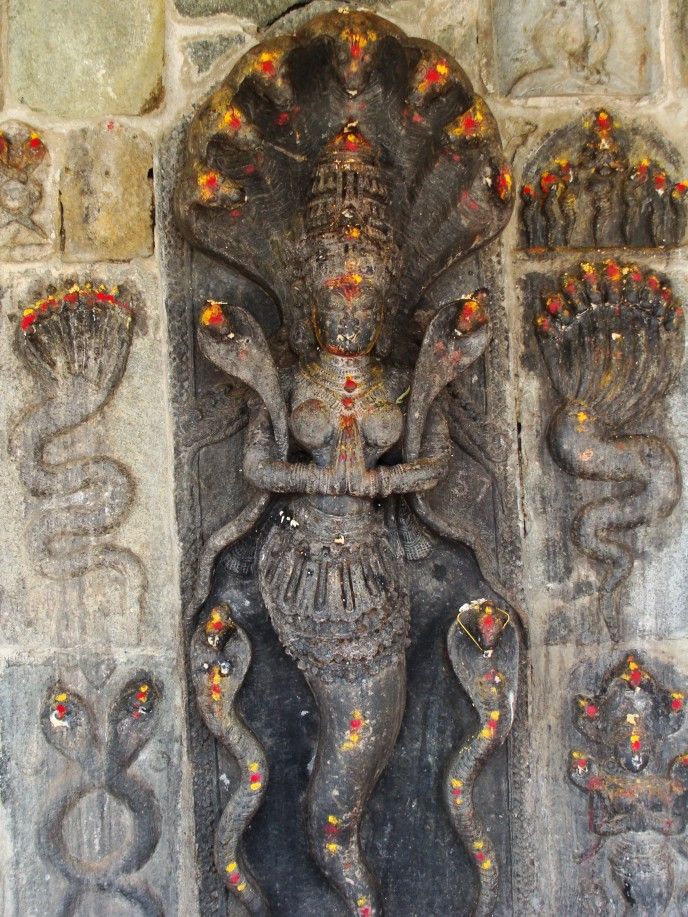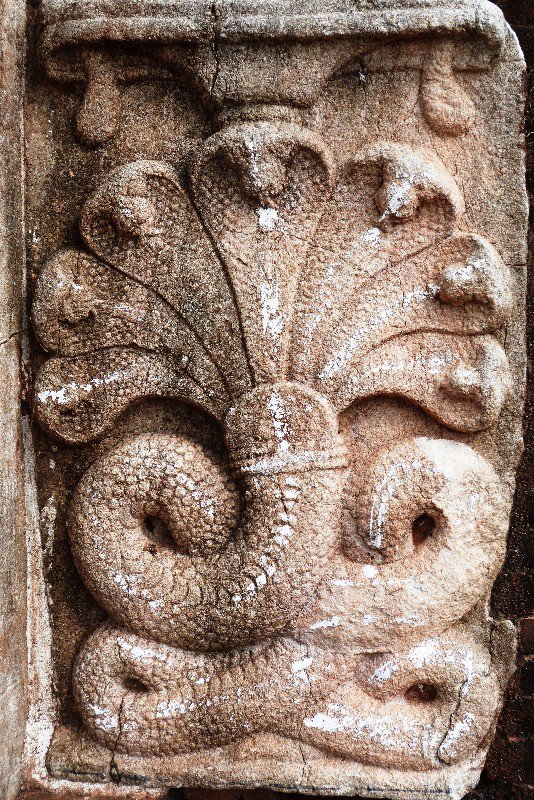Ancient Psychedelia: Alien Gods & Mushroom Goddesses
Online Book - Chapter 2, Page 41
Back to Online Book Mainpage / Next Page (Chapter 2, Page 42)
| In India, of course, we have many depictions of the snake goddess and she is symbolized by a serpent’s body and the head of a women with a cobra hood surrounding her head. The cobra hood is emblematic of the mushroom. This can be seen in several wall engravings, especially in the one where there is red paint at the top from Pambadi Pambumkav, India (18a), or where the serpent is depicted with seven heads (18c). (54) Snake goddesses have been portrayed in standing and squatting pose, with snake tails or with a snake head and sometimes with a human head and a long protruding serpent-type mouth. Sometimes the only thing characteristic of the serpent is the clothing depicting winding snakes. (55)  (18a) Pambadi Pambumkav, India  (18c) Seven Headed Naga |
Sometimes the serpent goddess is depicted with a child in her hands, and sometimes that child is a snake, and not a child. In the Ubaid culture previously mentioned, there is a figurine of a serpent goddess holding a serpent child (9e). (56) The goddess was depicted in the form of a serpent goddess in many cultures and this has led to some suspicions among conspiracy researchers and “ancient alien” buffs to believe that we were created by reptile people when you go far enough back into history. This is not true, but it makes very interesting dinner party conversation. Arthur Evans, in his Book, The Mycenaean Tree and the Pillar Cult, suggests that the serpent goddess worship was brought to Crete around the same time as the invasion of Egypt and the 1st Dynasty around 3000 BC, and further suggest that they were Egyptians who fled there escaping the invasion. (57) Symbols like the meanders, chevrons and zig zags are found on both snake and bird goddess pottery and figurines. The Greek goddess Athena, is associated with both birds and snakes. (58) The most dramatic example of the bird-snake combination is in the Aztec god Quetzal=bird-coatle=snake. (59) Serpents were originally adored and represented all things good, and then it shifted with the changes in patriarchy and the serpent became associated with evil. The question we should ask ourselves is whether it was the serpent that became evil, or what the serpent represented that became evil. Why would a serpent all of the sudden become evil under patriarchy, when it was worshiped under matriarchy? We could say the serpent represented “knowledge” and the patriarchy wanted to stamp out all forms of heretical knowledge, but there seems to be something deeper to it all. Is it possible that the mushroom was really the object of the affection and then detestation? I think perhaps this is so. The mushroom opens one up to higher knowledge and that makes it a “key” that opens a door. Why was the serpent selected, by the ancients as a symbol for the mushroom, is really what some people might be wondering. I believe it was selected because it comes up out of ground from a hole in the springtime, like the mushroom. It lives in the earth, thus giving it the Earth representation unlike the avian which belongs to the sky. Early humans had to find ways to relate characteristics and traits, because there was no written language, so symbolism became the predominant language and one of the ways the serpent came to symbolize the mushroom was by representing its stem, which sits in the earth. (54) The Language of the Goddess, p. 127 (55) The Language of the Goddess, p. 20 (56) When God was a Woman, p. 201 (57) The Language of the Goddess, p. 121 (58) Mythology and Symbols of the Mother Goddess, p. 173; (H. Husain, "La Grande Deesse-Mere" Paris. 1998, p. 29) (59) The Language of the Goddess, p. 134; W. Mannhardt, Letto-Preussische Gotterlehre. Riga: Lettisch-Literatische Gesellschaft 21, 1936, 433 |
Go Back to Page 40